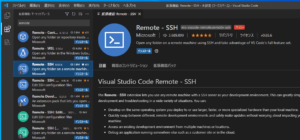

If the target machine has less than 1G of memory (say mininet VM), Java Language Support by George Fraser is preferred as it has less memory footprint. Note that all the plugins are running at the remote machine and this plugin is hungry at the memory. For Java developer, I suggest using Language Support for Java(TM) by Red Hat.If you are developing C or C++, the official C/C++ plugin is very useful for auto-completion, linting, etc.Along with the live share plugin, you can have collaborative debugging! See previous tutorial at For xv6 projects, you can install the "Native Debug" plugin for debugging.Live share is pretty helpful for pair-programming & group projects.You can now remote SSH to the CS Lab by clicking the newly-added entry under "SSH TARGETS"Ī new VSCode windows will pop up with the bottom right corner showing "SSH: CSLab" It reuses the ssh connection when you connect to the machine next time (within the timeout), so you don't need to enter the password or do anything. Add the CS Lab host to the file using the SSH config file format Select the first SSH configuration file to editģ. In the Remote Explorer view, click the Configure icon at the right of "SSH TARGETS"Ģ. I suggest enabling this so the password is entered in the terminal like normal ssh.ġ. For more detail, see įor the second setting, VS Code should automatically prompt you to enter the password, but I had some trouble seeing the prompt before. Setting the path of lockfiles to /tmp solves the problem.

Check the box for "Remote.SSH: Lockfiles In Tmp" and "Remote.SSH: Show Login Terminal"įile locking does not work when the home directory is mounted from an AFS. Install plugin "Remote - SSH" in the Extensions viewģ. Download Visual Studio Code from and install it.Ģ. This tutorial teaches you how to remote ssh to the CS Lab at University of Wisconsin-Madison using Visual Studio Code.


 0 kommentar(er)
0 kommentar(er)
